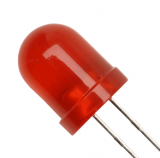Difference between revisions of "GPIO"
(Added LongPulse Command) |
|||
| Line 39: | Line 39: | ||
'''<nowiki>http://<ESP IP address>/control?cmd=Pulse,2,1,500</nowiki>''' | '''<nowiki>http://<ESP IP address>/control?cmd=Pulse,2,1,500</nowiki>''' | ||
| + | === Long pulses === | ||
| + | A long puls is basicly the same as the plain pulse. The only difference is the timebase in seconds rather than in milliseconds. So it's more suiteable for longer durations. | ||
| + | To send a long pulse to a certain pin: | ||
| + | |||
| + | '''<nowiki>http://<ESP IP address>/control?cmd=LongPulse,<pin>,<state>,<duration></nowiki>''' | ||
| + | |||
| + | Example to send an active high pulse on GPIO 2 for 10 minutes: | ||
| + | |||
| + | '''<nowiki>http://<ESP IP address>/control?cmd=LongPulse,2,1,600</nowiki>''' | ||
=== Servo motor control === | === Servo motor control === | ||
Revision as of 12:23, 27 April 2017
Contents
Introduction
The ESP module can control things with it's build-in GPIO output pins. We can turn these on or off or we can set these pins to a special Pulse modulated value (PWM output). And it's also possible to send short pulses (single puls) to one of these pins to control specific devices that are switched with a single short high or low signal.
Hardware
It's best to connect a LED to the GPIO to test your setup. You could dim this LED with the PWM mode commands.
Software
Custom Sketch
ESP Easy
You dont need a Device definition (task) to control basic GPIO output. You can always control all the pins by HTTP.
Basic on/off
We can control a pin with simple http url commands. To change the pin to high or low steady output:
http://<ESP IP address>/control?cmd=GPIO,<pin>,0
http://<ESP IP address>/control?cmd=GPIO,<pin>,1
PWM control
To set a certain PWM level:
http://<ESP IP address>/control?cmd=PWM,<pin>,<level>
Short pulses
To send a pulse to a certain pin:
http://<ESP IP address>/control?cmd=Pulse,<pin>,<state>,<duration>
Example to send an active high pulse on GPIO 2 for 500 mSeconds:
http://<ESP IP address>/control?cmd=Pulse,2,1,500
Long pulses
A long puls is basicly the same as the plain pulse. The only difference is the timebase in seconds rather than in milliseconds. So it's more suiteable for longer durations. To send a long pulse to a certain pin:
http://<ESP IP address>/control?cmd=LongPulse,<pin>,<state>,<duration>
Example to send an active high pulse on GPIO 2 for 10 minutes:
http://<ESP IP address>/control?cmd=LongPulse,2,1,600
Servo motor control
To control a Servo Motor:
http://<ESP IP address>/control?cmd=Servo,<servo nr>,<pin>,<position>
We currently support a maximum of two servo motors so you can build a pan & tilt device if you like.
Example to set servo 1 on gpio-0 to a 90 degree position and servo 2 on gpio-2 to a 45 degree position:
http://<ESP IP address>/control?cmd=Servo,1,0,90 http://<ESP IP address>/control?cmd=Servo,2,2,45
Tones
From ESPEasy v2.0.0-dev6 (in the testing plugin set) its also possible to play a tone on a pin, via a speaker or piezo element:
http://<ESP IP address>/control?cmd=tone,14,1300,200
Plays a 1300 hz tone for 200 ms on gpio-14h
Melodies and ringtones
From ESPEasy v2.0.0-dev6 (in the testing plugin set) its also possible to play melodies via [RTTTL]
(dont forget to remove the spaces)
http://<ESP IP address>/control?cmd=rtttl,14:d=8,o=5,b=180,c6,b,c6,p,g,g-,p,f,b,c6,p,d6,p,g,p,c6,b,c6,p,d6,p,f,g,g-,4p,g,f,4d-
This plays a melody on pin 14.
You can also use these from rules. We use it to let our alarm system give feedback to the user via a piezo speaker.
To make a boot-sound on startup, create a rule like this:
On System#Boot do rtttl,14:d=10,o=6,b=180,c,e,g endon
